When visiting our country, one of the most authentic experience you could have is tasting the food and drinks of Panama. Let us show you everything you need to know: from street food to gourmet dishes, from local beers, to marvelous craft beer and spirituous local drinks. Your visit to Panama will be unforgettable and delightful.
Table of Contents
What food is Panama known for
Traditional Panamanian cuisine is a unique combination of Afro-Caribbean, Spanish, and indigenous flavors.
A popular dish widely consumed throughout the country is Sancocho, a hearty chicken soup filled with root vegetables and served with a side of white rice.
Another is Arroz con Pollo (Chicken Rice). It’s a savory dish made with yellow rice and chicken, sprinkled with peas and carrots.
It’s hard for us to answer: What is the typical food of Panama? We’d probably say Panamanian Arroz con Pollo (Chicken Rice). But the most consumed food in Panama is probably Sancocho.
You can find sancocho almost everywhere, and there is a local debate about what the traditional ingredients are. Some people claim it must include otoe and yam, while others say it only contains cassava. “Otoe” and “yam” are names of root vegetables often used in Panamanian cuisine.
The same goes for herbs: some people use “culantro,” while others say it’s just “cilantro.”
We definitely recommend asking your tour guide to try a sancocho, and let us know in the comments what was included in yours and if you liked it.
Some other very popular and delicious dishes you can try are:
- Carimañola: Carimañolas are fried yuca fritters stuffed with seasoned meat or cheese.
- Tamales: Tamales are a traditional Panamanian dish made from corn dough, filled with meats, vegetables, or fruits, wrapped in a banana leaf, and then steamed.
- Saus: Pickled pig’s feet seasoned with a mix of onions, cucumbers, vinegar, and peppers.
- Bollo de maíz nuevo: The corn is ground into a dough that is wrapped in the husk of the cob and is boiled in water until it reaches the desired firmness.
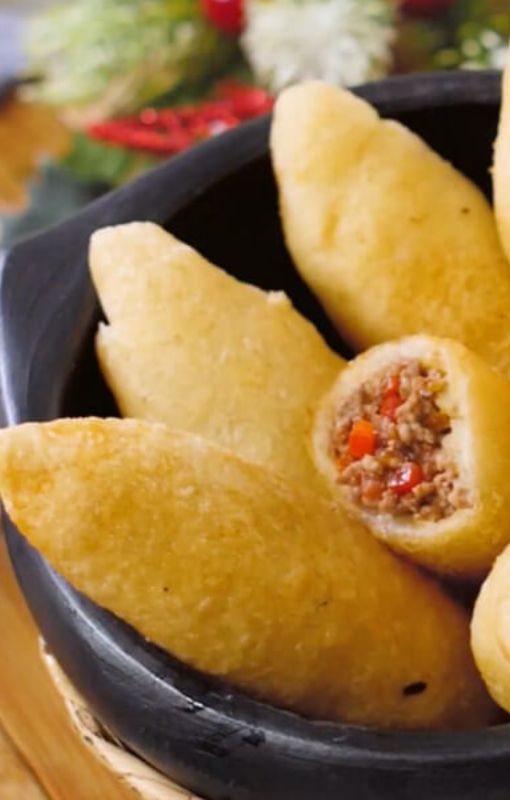
- Hojaldre: Hojaldre is a Panamanian fried bread, light and flaky in texture, often served for breakfast or as a side with meals.
One of the most traditional restaurants of the city where you can try any of this delicious dishes is El Trapiche.
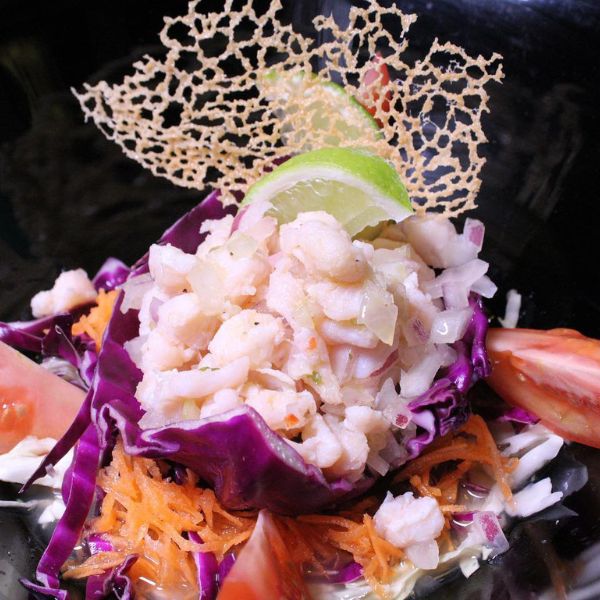
Additional from the Sancocho or the Arroz Con Pollo, in Panama City, the national pride and joy is the Ceviche.
A delightful seafood dish that consists of raw fish cured in citrus juices and mixed with onions, celery, and a dash of hot peppers.
It’s refreshing, tangy, and absolutely delicious!
You can try it in the Mercado del Marisco for a super fresh ceviche, made with fish, caught by local fishermen on the same day.
You could say that there is not just one national dish of Panama City, it could be the ceviche, the sancocho, the arroz con pollo or the tamales.
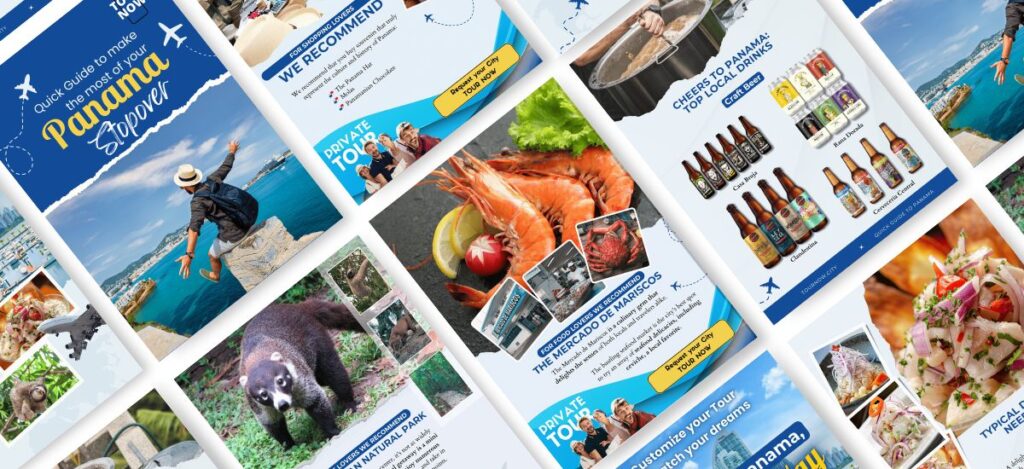
GET FOR FREE your Quick Guide to make the most of your PANAMA STOPOVER
Download the FREE GUIDE with all the details to make the most of your stay in Panama.
A Typical Breakfast and Lunch in Panama
A typical breakfast in Panama consists of tortillas de maíz (cornmeal fritters), eggs, and carne desmechada (shredded meat), accompanied by a cup of hot Café Durán, Panama’s famous coffee.
But if you want something sweeter, get some Hojaldres sprinkled with powdered sugar.
For lunch, the common lunch in Panama is a plate of Arroz con Guandu (rice with pigeon peas), served with Ropa Vieja (slow-cooked beef), fried fish, or braised chicken, accompanied by patacones (fried plantain slices).
If you haven’t tasted patacones: please do so!! Is extremely delicious.
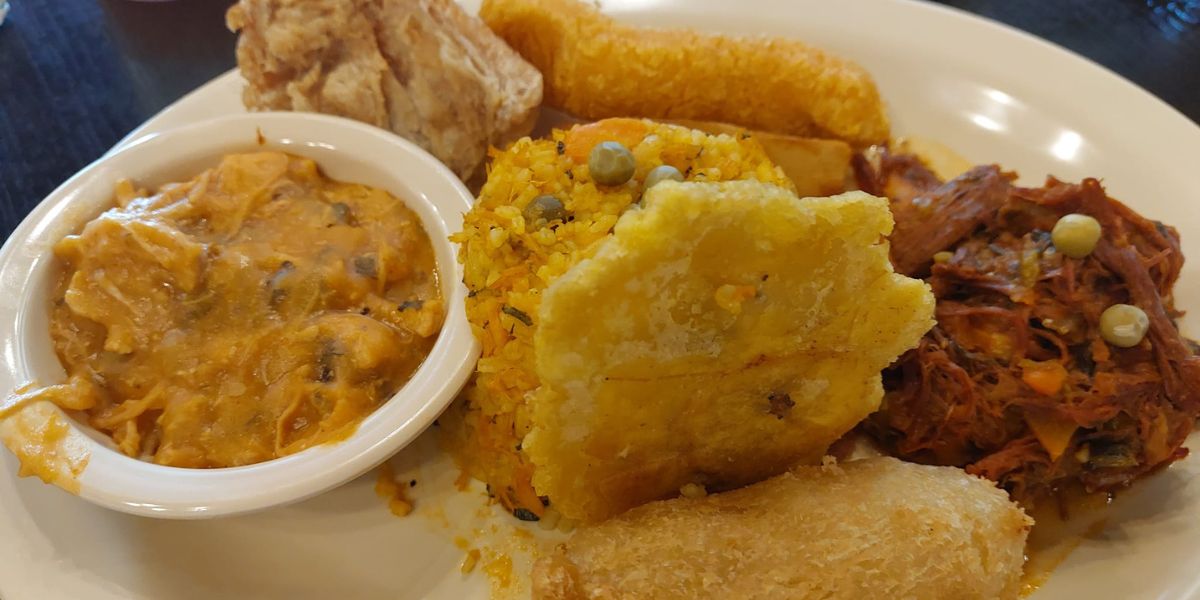
A typical snack in Panama: Panama Food and Drinks
Popular snacks include carimañolas or enyucados (fried balls of manioc dough filled with meat), empanadas, tamales, patacones (fried, mashed and refried plantains) and hojaldres (discs of deep-fried leavened bread).
Must-Try Snacks and deserts in Panama for a local would be Yuca Frita, you can’t go wrong with Yuca Frita (cassava fries) or the delicious twice-fried plantains: Patacones.
Some people enjoy also a ceviche in the middle of the afternoon or while having some drinks, and you can add to this Yuca Frita or Patacones.
On the sweet side,
“raspadura“, unrefined whole cane sugar, is often used in creating confections or sweet drinks, offering a taste of the local farming produce. In simple terms, a Raspadura would be a lemonade sweetened with molasses. It is delicious and refreshing.
For dessert, nothing is more Panamanian and refreshing than a: Raspado. It is a delightful Panamanian treat that is especially popular on a hot day.
Raspado is a kind of shaved ice dessert available in multiple flavors, often topped with sweet syrups, various fruit options, and even condensed milk.
A popular choice among locals and tourists alike, Raspado is a perfect way to finish off a meal or to simply enjoy as a treat while exploring the charming streets of Panama.
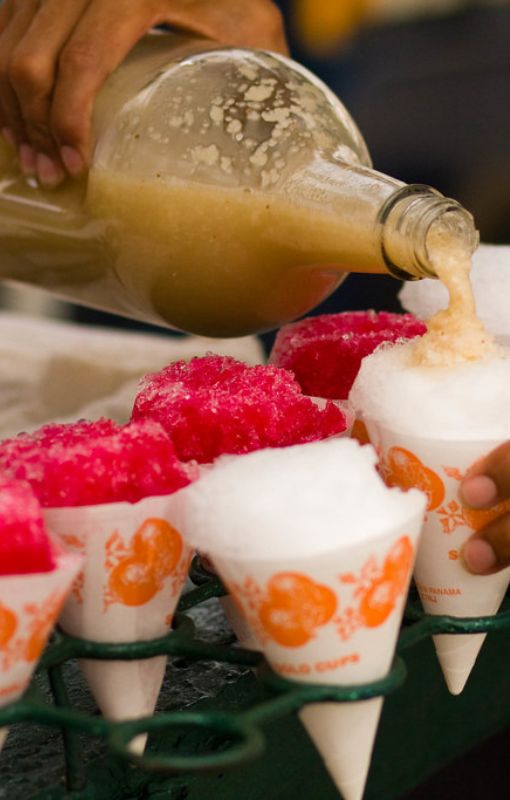
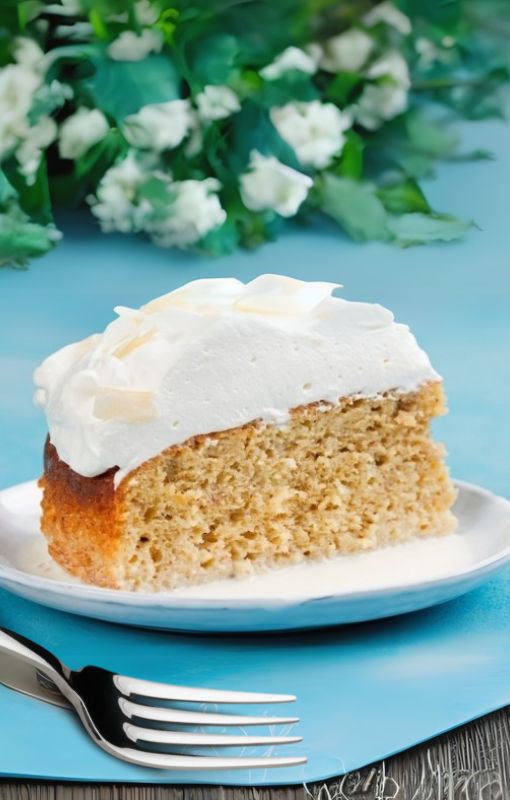
Some other local deserts are:
Bocado de la Reina is an exquisite pound cake soaked in wine and syrup.
Mamallena is a unique raisin and cinnamon bread pudding, occasionally infused with a dash of rum.
A distinctive dessert drink, Chicheme Chiricano, is a sweet blend of corn, milk, and traditional spices, usually served warm.
Finally one that you will only find in Panama: Pesada de Nance. It’s a type of custard prepared with “nance”, a small yellow fruit locally known and appreciated for its unique, aromatic taste.
Combined with sugar, the nance gives the dessert a sweet yet mildly tart flavor. This creamy, rich custard often rounds off a traditional Panamanian meal, and it’s definitely a treat you should not miss when exploring the local cuisine.
Eating Schedules in Panama: What to Expect
If you want to know at what time do people eat in Panama, here is a brief schedule:
Breakfast is usually eaten between 6:30-7:30 am. Yes, people get up early and go to work or school pretty early. Local schools start at 7:30 am!
Lunch is between 12-1 pm. Off-course, if you woke up at 5:30 am, you are already hungry at noon. So Panamanians have lunch early too.
Dinner around 7 pm. Since the sunset is always between 6 and 6:30 pm, dinner is normally served close to 7 pm, and people go to bed early during weekdays, ‘cause they have to wake up at 5 am!
Panamanians are quite punctual with their meal times, so it’s wise to plan your day accordingly if you are eating with locals. However, restaurants are very flexible and have a wider range for breakfast and lunch hours, specially if you are in a touristic spot, like Casco Viejo.
Keep in mind that if you want to have the daily special or a lunch combo, it will be probably sold out before 1pm.
Regarding prices, you can find a huge range for a lunch. Going from 5 dollars in a local small restaurant, ordering the “lunch special” to a hundred if you order from the menu, including the appetizer, main course, dessert, and wine.
Do not hesitate to look at the menu before entering the restaurant or asking for the prices. Most restaurants have their menu at the entrance, and it is ok to look at the menu before you decide if you want to eat there.
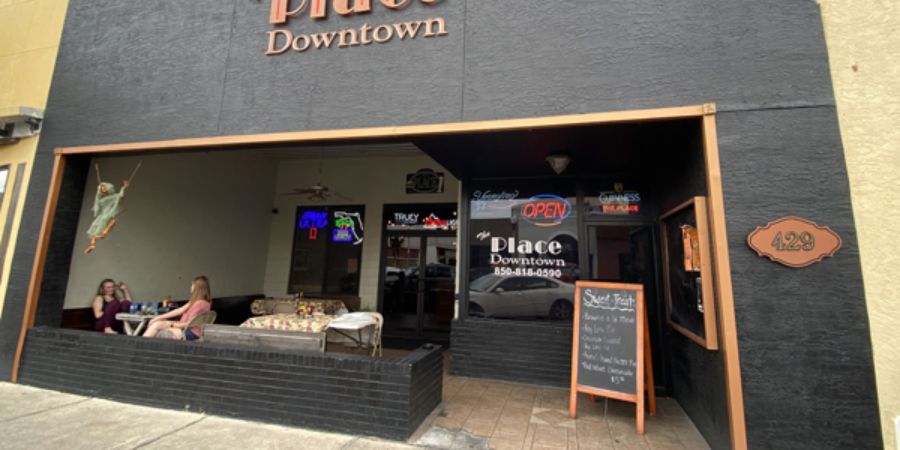
Is it safe to drink tap water in Panama?
The tap water in Panama City and most towns and cities is generally safe to drink.
However, in rural areas it is better to stick to bottled water. If you are not used to drink tap water in your home country, we do not recommend that you star this practice here in Panama.
It is better to avoid a stomach ache while on vacation, and the bottle of water is not expensive at all. In conclusion, although it is safe to drink tap water in Panama, we recommend you to drink bottled water during your trip, just to avoid any complaints from your digestive system.
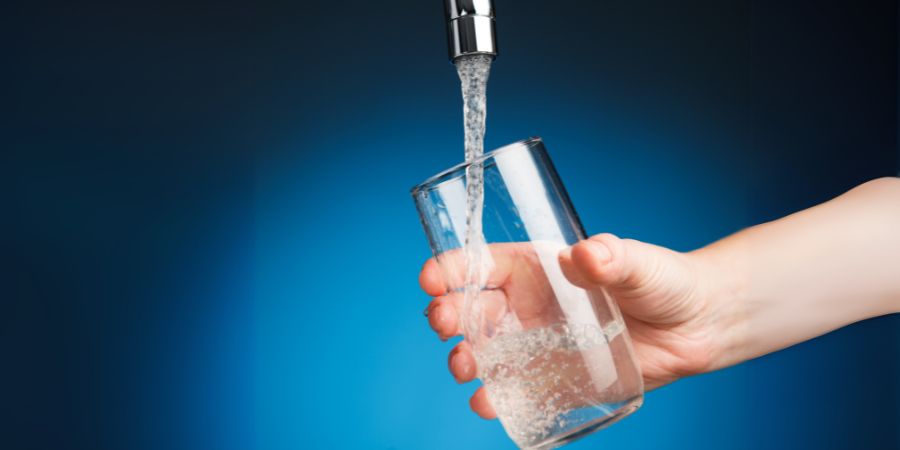
Cheers to Panama: Top Local Drinks
Panama’s drinks are as diverse as its culinary scene. For something non-alcoholic, try Chicha, a traditional drink made from fruits, rice, or corn. You can also try the Raspadura we talked about before.
Beers to try in Panama:
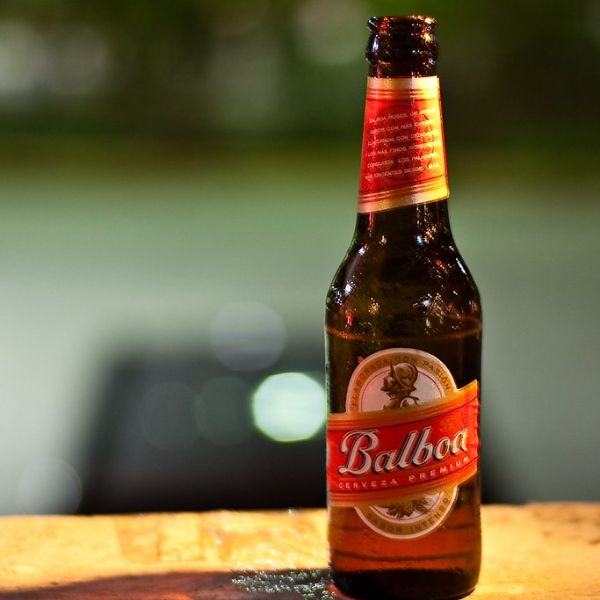
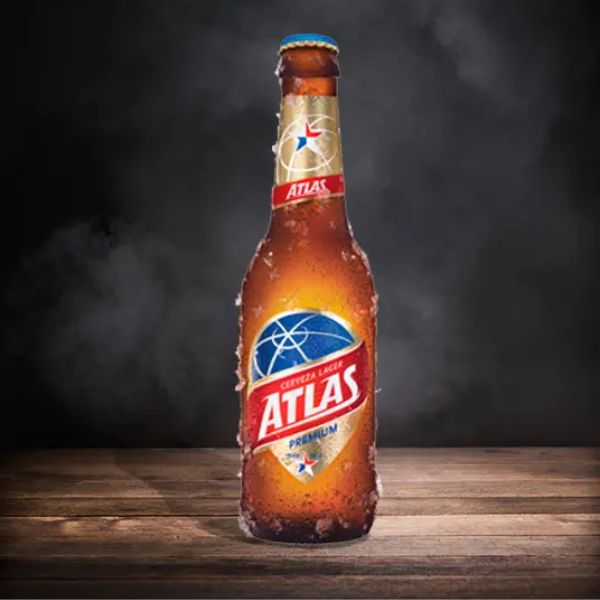
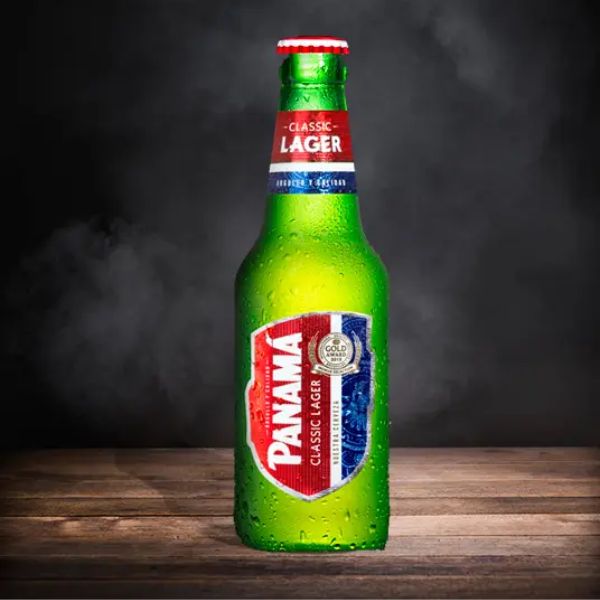
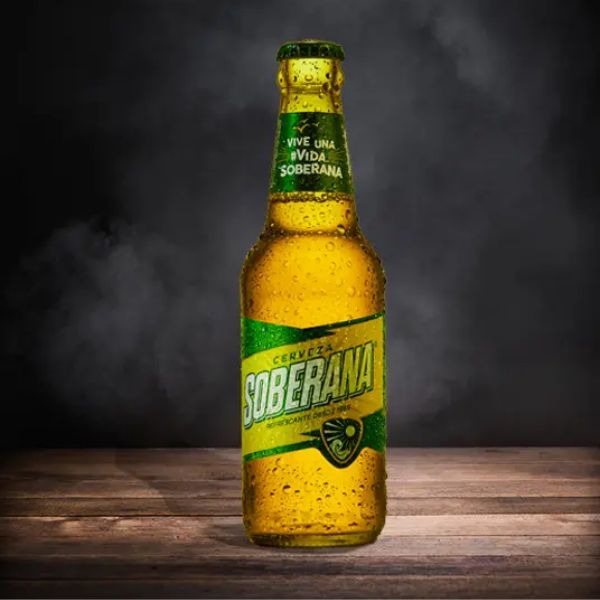
If you love beer, you will have a blast in Panama.
We invite you to indulge in the big variety of charming beers of Panama. Whether you like traditional beers or craft beers with very peculiar flavors, there’s for everyone’s taste.
If you want a classic beer you have 4 options:
- Balboa
- Atlas
- Panamá
- Soberana
The prices of those in a restaurant go between 3 to 5 dollars, depending on the location of the restaurant or bar. In a supermarket you can buy them from 0.80 to 1.20 approximately.
If you want a local craft beer to enjoy your Panama Food and Drinks on your visit?
Well, you have much more options, since craft beers are in fashion in the country. However, they don’t have all the options in the restaurants, but if you want to do a beer tasting, go to a local big supermarket, and you will have lots of fun choosing your beers. Ask your tour guide who can take you to specialized bars or supermarkets to buy them.
Here is the list of the local breweries. Some of them have tours of their plants or a dedicated bar, and some have won international prices. Even the names of the beer are so artistic, reminding of local expressions, like:
- Xa’madre (an informal expression which can be roughly translated as “damn”)
- or recalling a key historical moment: Tajada de sandía (referring to an event in 1856 when a conflict erupted between Panamanians and Americans over an American’s refusal to pay for a slice of watermelon),
- naming the local pest Chitra (the sand flies)
- or even local legends: La Tulivieja (is a folkloric story about a ghostly woman who roams riverbanks at night, crying for her lost child)
Ask your local tour guide if you want more information
The following are the biggest craft beer breweries in Panama:
Founded in 2015, they are in almost every supermarket and bar, and they have a taproom, where they have live music.
Their beers are:
- Guachiman
- Mangose
- River Down Ale
- Veranera
- Lagertija
- India Dormida
- Bocas Town
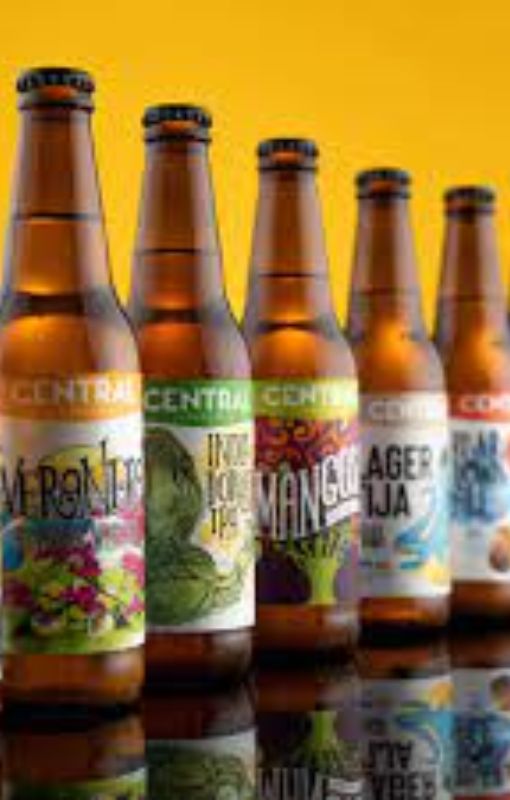
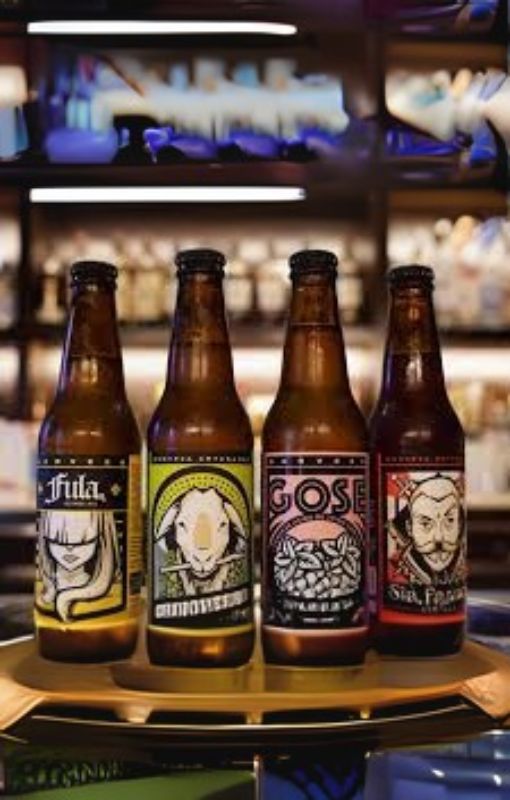
This is the brewery that has the most variety, and they also have more than 40 international medals. You can easily find them in the supermarket and in most bars and restaurants:
- Fula
- Tres Tristes Tigres
- Chitra
- Chivo Perro
- Sir Francis
Some others from the same brewery:
- Talingo
- Gose Frambuesa
- Gose Limón Kaffir
- Macho De Monte
- Madretambor
- Hijo de Lindbergh,
- Tajada de Sandía
- Flower Sour
- La Tulivieja…
You can request a tour of the brew house or go to one of their tap rooms to have a beer, eat and even buy merchandise
3. Cervecería Clandestina
Founded in 2017, they have already won an international medal and you can book a tour of the brewhouse.
Their beers are:
- Intriga
- Ley Seca
- Rapiña Nómada
- Xa´madre
- Guerra Fría
- Malambo
- Madhammer
- Malek Hoppy Pils
- Vela Negra
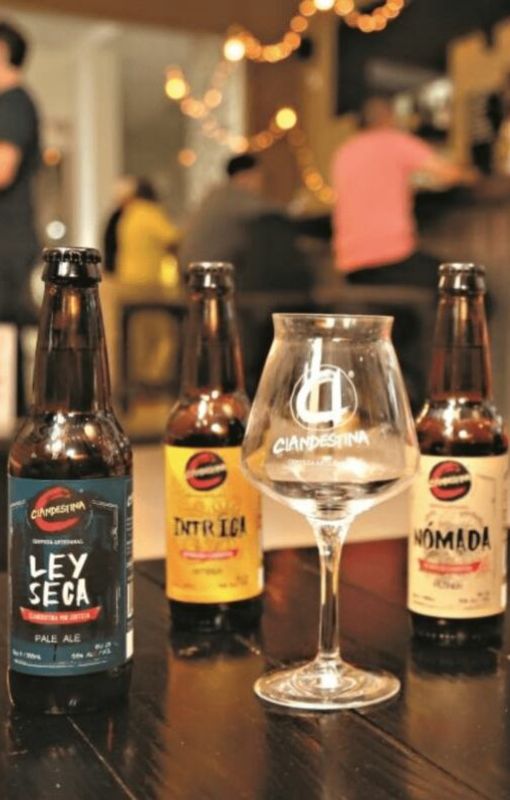
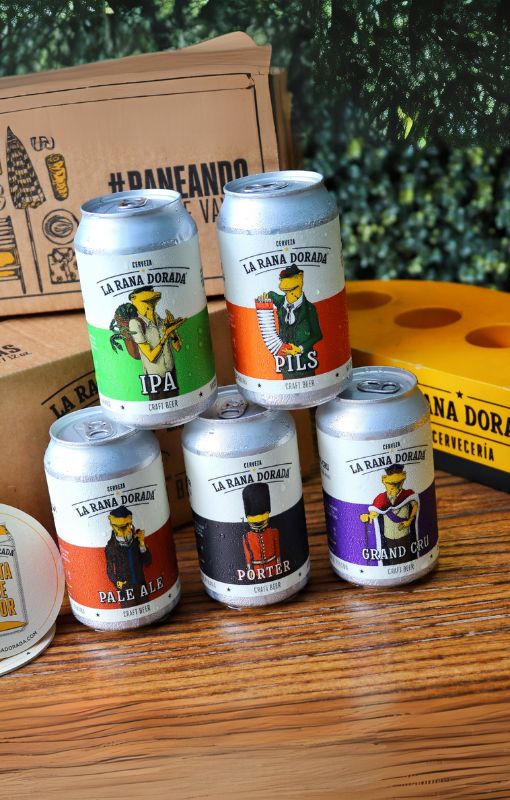
4. Rana Dorada
La Rana Dorada is the most famous endemic animal of Panama. It is the emblem of this company, showing its Panamanian roots and deep attachment to the country. They have almost 10 pubs throughout the city, and you can request a tour of the brew house too. What’s interesting is that they also have a local Rum: Pedro Mandinga, made with molasses. You can try that too during you visit.
They have 6 types of beers:
- Pils
- Pale Ale
- Grand Cru
- Blanche
- Porter
- Grand Ipa
This is a flourishing market and more companies are arising.The following ones are less famous, but you can find them in the big supermarkets and they are also very good:
5. La Murga
They have mainly 5 beers:
- Momo (Fruit Sour)
- Encantada (Belgian pale ale)
- Apasionada (IPA)
- Atrevida (Kölsch)
- Noctambula (English Porter)
6. Mulata
They have 4 beers:
- Catalina Blonde
- Etnia: Dark European Lager- Schwarzbier
- Palente: Strong Belgian Ale
- Nina Strawberry Sour: Catharina Sour
7. Boquete Brewing Company
This company from the Chiriqui province have
- Agua Selva
- Smash
- Mudate o Muerete
- La Coima
- Bird Song
- Hammock Time
- Wood Moring
- Portergeist
8. Two oceans brewing company
This company was founded in 2016 and have 4 beers:
- Witnic (Belgian Witbier)
- Tropty (India Pale Ale)
- Invasion (American Pale Ale)
- Swithc (Blonde Ale)
You can find it on bars around the city and in supermarkets too.
9. Strange Beers PTY
- Summer Nights (Blonde Ale)
- Instant Crush (Blonde Ale)
- Eleven (Catharina Sour)
- Betahell
- Magdalena (Belgian Tripel)
- Sorachi (IPA)
- Tonight Pastry Stout
10. VILLA 5ta
They have just one beer for the moment and you can find them at the big supermarkets or liquor stores.
- Q XOPA (Belgian Pale Ale)
Spirit Drinks
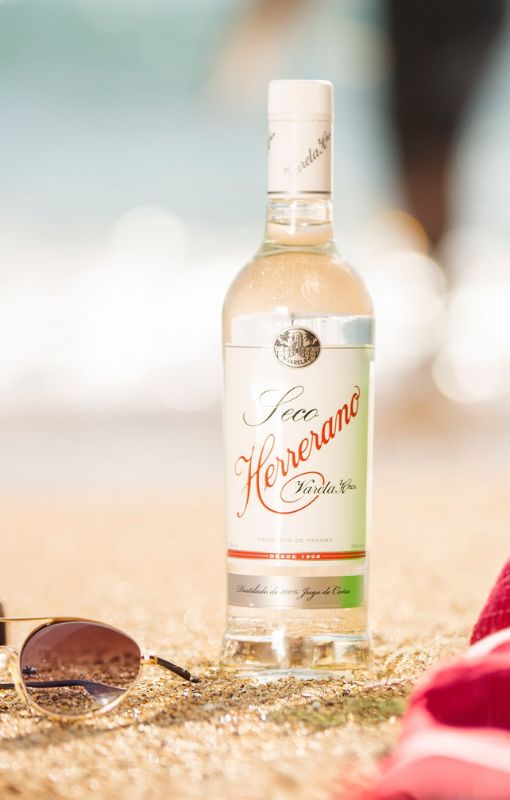
The drink Panama is known for is the Seco Herrerano. Panama’s most famous drink is seco, a sugar-cane-distilled alcohol produced in the Herrera Region and commonly served with milk and ice.
You won’t find seco in trendy bars or high-end restaurants; it’s consumed mostly in rural communities and cantinas.
It is a budget-friendly beverage, so it is not very fancy. However, we recommend you to try it with tonic water and lemon.
This is a local recipe to upscale the drink: a Panamanian Gin Tonic.
You can find the Seco in plastic bottles, so it is an interesting, safe and affordable gift to bring back to your country.
Beyond the Seco, you can also find local rums, a local favorite is “Ron Abuelo”, with its smooth, complex taste profile that includes hints of vanilla and caramel.
If you want to go further and are seeking something truly robust, there’s “Guarapo,” a fermented drink made from sugarcane juice. The fermentation process lends it a stronger kick and a rustic flavor that resonates with Panama’s rural traditions.
On festive occasions, Panamanians might also enjoy “Saril,” a liquored-up hibiscus drink usually prepared during the Christmas season. Infused with cloves, ginger, cinnamon, and sometimes a heavy splash of rum, it’s a celebratory drink that warms the soul and enlivens the spirit.
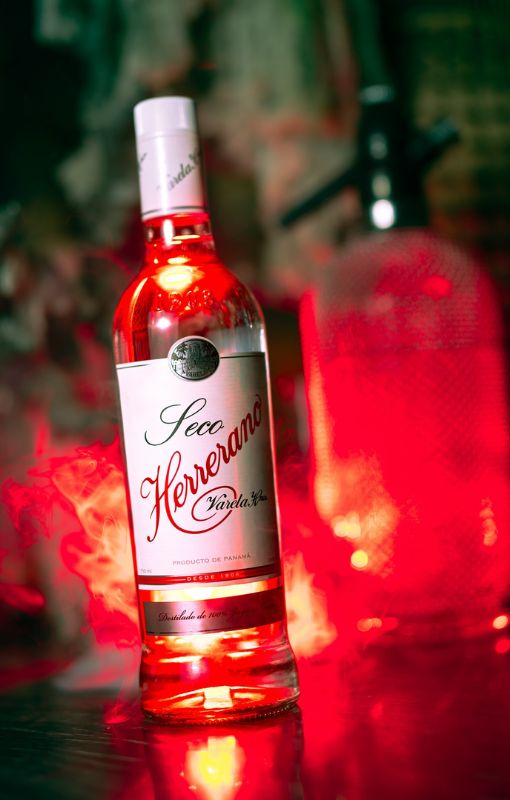
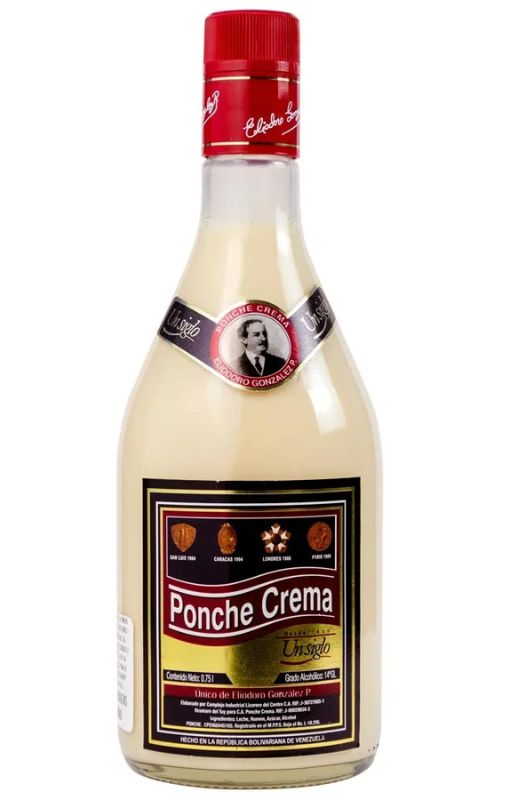
Of course, let’s not forget about “Ponche Crema”, a staple in Panamanian households during the festive Christmas season.
Ponche Crema is a creamy, sweet, and smoothly potent libation often equated to a Panamanian-style eggnog.
The drink’s richness comes from a blend of condensed and evaporated milk, while its spirituous character flows from the generous inclusion of Seco or rum. As a nod to the holiday spirit, this delectable concoction is seasoned with vanilla, nutmeg, and a touch of cinnamon, lending it comforting warmth.
Something to remember if you are traveling with young people, is that the drinking age in Panama is 18 years of age. You might be asked for a document to verify your age before buying any alcoholic drink at a restaurant or supermarket. This means also, that young people will be allowed to drink in Panama, even-tough they cannot do it in their home countries.
How much will you spend on drinks?
It will depend on the restaurant or bar you choose and the kind of drink you will have.
Roughly we could say that at a bar or restaurant prices will go around this:
- Traditional beers will go from 3 to 5 dollars.
- A craft beer will range between 5 to 7 dollars,
- A spirituous drink like rum, scotch, vodka or similar, will range between 7 to 10 dollars, depending on the brand and quality of the drink.
- And a cocktail will go from 10 to 15 dollars.

So remember, if you are visiting the city, we recomend you to do it with a certified bilingual tour guide, who can really show you the beauties of this marvelous city of Panama, and make you taste the real Panama food and drinks. Just click below and book and …
Let us take care of you.



